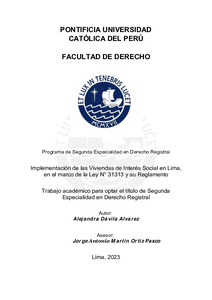Implementación de las viviendas de interés social en Lima, en el marco de la Ley N° 31313 y su Reglamento
Abstract
El presente trabajo pretende dar una visión sobre la implementación de los
proyectos de Viviendas de Interés Social en la ciudad de Lima, tomando en
consideración tanto el crecimiento urbano y el desarrollo histórico de la ciudad,
como el fenómeno de la migración hacia la capital. Se realiza al inicio un análisis
de la estratificación de la población desde la colonia, a efectos de determinar la
forma de agruparse y afincarse en determinado territorio, desde el centro de la
ciudad hacia la periferia. Esto con el objetivo de establecer si los distritos más
privilegiados de Lima son partidarios de incluir los proyectos de viviendas de
interés social dentro de su jurisdicción, teniendo en cuenta que desde un inicio
han intentado aislarse de los barrios populosos y de menores ingresos, poniendo
así de manifiesto la segregación de la población y los diferentes estratos sociales
en relación al crecimiento de la ciudad. Se advierte también el rechazo a estos
proyectos en determinadas zonas amparados en el conflicto de competencia
entre las municipalidades y el Ministerio de Vivienda, que ha sido zanjado
recientemente por un fallo del Tribunal Constitucional, pero teniendo como
conclusión la imperiosa necesidad de impulsar y promover proyectos que ayuden
a que las personas puedan acceder a una vivienda digna, lo que constituye un
derecho. This work aims to give a vision of the implementation of Social Interest Housing
projects in the city of Lima, taking into consideration both the urban growth and
historical development of the city, as well as the phenomenon of migration to the
capital. At the beginning, an analysis of the stratification of the population from
the colony is carried out, in order to determine the way to group and settle in a
certain territory, from the center of the city to the periphery. This with the objective
of establishing whether the most privileged districts of Lima are in favor of
including social housing projects within their jurisdiction, taking into account that
from the beginning they have tried to isolate themselves from the populous and
lower-income neighborhoods, thus putting highlights the segregation of the
population and the different social strata in relation to the growth of the city. The
rejection of these projects in certain areas is also noted, protected by the conflict
of jurisdiction between the municipalities and the Ministry of Housing, which has
been recently settled by a ruling by the Constitutional Court, but with the
conclusion that there is the need to promote projects that help people to access
decent housing, which constitutes a fundamental human right.
Temas
Vivienda social--Perú
Vivienda--Aspectos sociales--Perú
Política de vivienda--Perú
Vivienda--Aspectos sociales--Perú
Política de vivienda--Perú
Para optar el título de
Segunda Especialidad en Derecho Registral
Collections
The following license files are associated with this item:






